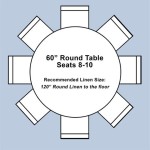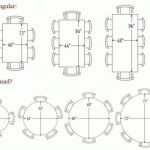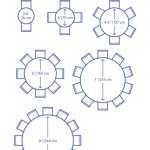What Size Rug For Round Dining Room Table With 4 Chairs: A Complete Guide
Selecting the correct rug size for a round dining room table with four chairs is a crucial design decision that impacts both the aesthetics and functionality of the space. A rug that is too small will appear disproportionate and can make the dining area feel cramped. Conversely, a rug that is too large might overwhelm the room and encroach on other furniture.
The primary purpose of a dining room rug is to define the dining area, add visual interest, and provide a comfortable surface underfoot. The rug should be large enough to accommodate the chairs even when they are pulled out from the table, ensuring guests have a smooth transition when sitting down or standing up. Failure to achieve this can result in chairs catching on the rug's edge, creating a tripping hazard and damaging both the rug and the floor.
Several factors influence the ideal rug size, including the diameter of the table, the size of the chairs, the overall dimensions of the dining room, and personal aesthetic preferences. Understanding these factors and applying appropriate guidelines will help in choosing a rug that is both practical and visually appealing.
Determining the Minimum Rug Size: The 24-Inch Rule
The most fundamental principle in selecting a rug for a dining table is the "24-inch rule." This rule states that the rug should extend at least 24 inches beyond the edge of the table on all sides. This measurement ensures that when a chair is pulled out, its back legs remain on the rug, providing stability and preventing the chair from catching on the edge. This buffer zone minimizes the risk of tripping and protects the flooring underneath.
To apply the 24-inch rule, begin by measuring the diameter of the round dining table. For example, if the table has a diameter of 48 inches (4 feet), add 48 inches (24 inches on each side) to the table's diameter. This results in a minimum rug diameter of 96 inches (8 feet). Therefore, for a 48-inch round table, an 8-foot round rug is generally the smallest acceptable size.
It is important to note that the 24-inch rule represents the minimum requirement. In larger dining rooms, a larger rug might be more visually balanced and contribute to a more luxurious aesthetic. The rule serves as a foundation upon which adjustments can be made based on the room's specific characteristics and the desired design style.
When selecting a rug based on the 24-inch rule, it is also essential to consider the shape of the rug. While a round rug will mirror the shape of the table, a square or rectangular rug can also be used effectively. In such cases, ensure that the rug is wide and long enough to accommodate the chairs when pulled out, adhering to the minimum 24-inch extension on all sides. The final choice depends on the room's layout and the overall design vision.
Beyond functionality, the rug provides an opportunity to introduce color, texture, and pattern into the dining area. These elements enhance the room's visual appeal and contribute to a cohesive and inviting atmosphere. The rug can act as a focal point, tying together the various elements of the room, including the table, chairs, and other decorative accessories.
Considering Room Size and Layout: Maintaining Proportionality
While the 24-inch rule provides a baseline for rug size, the overall dimensions and layout of the dining room play a crucial role in determining the ideal size. A rug that adheres to the 24-inch rule might still appear too small or too large if it is not proportional to the room. Maintaining visual balance is essential for creating a harmonious and aesthetically pleasing space.
In a small dining room, a rug that is too large can overwhelm the space, making it feel cramped and cluttered. In such cases, it might be necessary to slightly reduce the rug size, ensuring that it still meets the minimum requirements of the 24-inch rule. Alternatively, consider using a lighter colored rug to create a sense of airiness and openness.
In a large dining room, a rug that adheres strictly to the 24-inch rule might appear inadequate and insignificant. In this scenario, consider increasing the rug size to better fill the space and create a more substantial visual impact. A larger rug will help to define the dining area and prevent it from feeling lost within the larger room. It might be necessary to extend the rug beyond the 24-inch minimum to achieve the desired effect.
The placement of other furniture in the dining room also influences the rug size decision. If there are other pieces of furniture, such as a sideboard or a china cabinet, consider how the rug will interact with these elements. Ideally, the rug should either extend underneath the front legs of these furniture pieces or be positioned entirely away from them. Avoid situations where the rug only partially extends under furniture, as this can create a visually disjointed and awkward appearance.
When evaluating room size and layout, consider the traffic flow within the dining area. The rug should be positioned in a way that minimizes obstructions and allows for easy movement around the table and to other areas of the room. Avoid placing the rug in a location where it creates a bottleneck or interferes with pathways. The rug should enhance the functionality of the space, not hinder it.
The shape of the room also has an impact on the rug size and shape. In a square or rectangular dining room, a square or rectangular rug might be the most visually appropriate choice. In a more irregularly shaped room, a round rug can help to soften the angles and create a more cohesive look. Consider the architecture of the room and choose a rug shape that complements its proportions and design.
Material, Pile Height, and Color: Enhancing Functionality and Aesthetics
Beyond size and shape, the material, pile height, and color of the rug significantly impact both the functionality and aesthetics of the dining room. Choosing the right combination of these elements can enhance the room's overall design and create a more comfortable and inviting atmosphere. The material should be durable and easy to clean, the pile height should be appropriate for dining chairs, and the color should complement the room's existing palette.
For dining rooms, durable and stain-resistant materials are highly recommended. Wool rugs are a popular choice due to their natural durability, stain resistance, and luxurious feel. Synthetic materials, such as polypropylene, are also a good option, as they are less expensive than wool and offer excellent stain resistance and ease of cleaning. Consider materials that can withstand spills and frequent foot traffic.
The pile height of the rug should be chosen with consideration for the dining chairs. A low-pile rug is generally preferred, as it allows chairs to move easily and prevents them from getting caught or snagged. High-pile rugs, such as shag rugs, can be difficult to navigate with dining chairs and may create an unstable surface. Low-pile rugs also tend to be easier to clean, which is an important consideration for a dining area.
The color of the rug can significantly impact the mood and style of the dining room. A light-colored rug can brighten a dark room and create a sense of spaciousness, while a dark-colored rug can add warmth and richness. Consider the existing color palette of the room and choose a rug color that complements or contrasts with the walls, furniture, and accessories.
Patterned rugs can add visual interest and personality to the dining room. Consider a rug with a subtle pattern to add texture and depth without overwhelming the space. Geometric patterns, floral designs, and abstract motifs can all be effective choices, depending on the overall style of the room. Avoid patterns that are too busy or distracting, as they can detract from the dining experience.
When selecting a rug color, consider the potential for spills and stains. Lighter colors tend to show stains more easily than darker colors. If you are concerned about spills, consider choosing a rug with a darker color or a patterned design that will help to camouflage stains. Alternatively, consider using a rug pad underneath the rug to protect it from spills and stains.
Ultimately, the choice of material, pile height, and color is a matter of personal preference. However, it is important to consider the practical aspects of each element to ensure that the rug is both functional and aesthetically pleasing. By carefully considering these factors, it is possible to choose a rug that will enhance the dining room's overall design and create a comfortable and inviting space.
Selecting the correct rug size and style for a round dining room table with four chairs is a multifaceted process that requires careful consideration of various factors. By adhering to the 24-inch rule, considering the room's size and layout, and carefully selecting the material, pile height, and color, it is possible to choose a rug that enhances the room's aesthetics, functionality, and overall ambiance.

Rules Of Thumb For Rugs Under Round Dining Tables Inspiration

Rules Of Thumb For Rugs Under Round Dining Tables Inspiration

Rules Of Thumb For Rugs Under Round Dining Tables Inspiration

6 Rules For Choosing A Dining Room Rug Pretty Souces Stonegable

Round Rug Size Guide For 36 42 48 54 60 72 Inch Tables Rugs Direct

Round Rug Size Guide For 36 42 48 54 60 72 Inch Tables Rugs Direct

Simple Rules For Dining Room Rugs Floorspace

Round Rug Size Guide For 36 42 48 54 60 72 Inch Tables Rugs Direct

How To Choose The Right Dining Room Rug Size

Image Result For Round Dining Table 4 Chairs Rug Room Size
Related Posts








